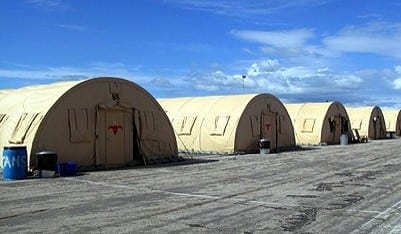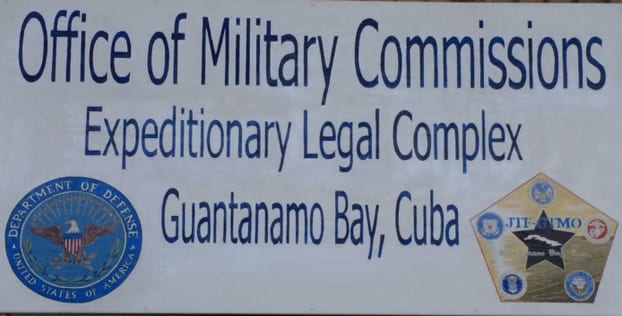 SMU Dedman School of Law Prof. Chris Jenks is visiting Naval Station Guantanamo Aug. 11-15. This is the second blog of the series.
SMU Dedman School of Law Prof. Chris Jenks is visiting Naval Station Guantanamo Aug. 11-15. This is the second blog of the series.
Escorts for the Office of Military Commission separate the various entities — prosecution, defense, victims’ families, media, non-governmental organizations (NGOs) —to take them to different sections of the base. For some of us that means Camp Justice.
Camp Justice, and indeed all of Naval Station Guantanamo Bay, can seem a bit surreal at times.
The camp was set up as a temporary facility, with a series of hardstand tents and living trailers set atop asphalt, but it’s existed more than 10 years now.
What one thinks of the setup is a matter of perspective. When compared to a civilian home or hotel room, it’s not great. But when compared to regions of military deployment like Iraq or Afghanistan, it seems fine.
 Our escorts tell us members of the media are also at Camp Justice but staying in a different section. They also tell us that if NGO reps want to interact with the media or vice versa, they can do so only via request from the escorts, which I find odd.
Our escorts tell us members of the media are also at Camp Justice but staying in a different section. They also tell us that if NGO reps want to interact with the media or vice versa, they can do so only via request from the escorts, which I find odd.
Stranger still is when our escorts tell us to avoid the U.S. military members on the base — if we “don’t bother them, they won’t bother you.” What a missed opportunity for the NGOs to learn about the U.S. military while in a deployed setting.
For the groups staying at Camp Justice, there’s a tent for males and a tent for females, each with seven beds, some lighting, a few power outlets and a small refrigerator. And while there are some plywood partitions, it’s definitely communal living.
- Tent interior
- Tent bed
- Sink setup
About 100 yards away are segregated laundry, bathroom and shower trailers which weren’t as well equipped as the ones I used while deployed in Bosnia and Iraq in 1994 and 2004, respectively.
Sinks and showers, for example, have only one knob — on and off. So when you turn on the water it’s initially freezing but then starts to warm up — before becoming scalding. I think the conditions are more austere at Gitmo than elsewhere because no one envisioned the need for these “temporary” facilities to last so long, especially given everything at Gitmo being difficult to acquire (water and power, for instance) due to the strained relationship between the U.S. and Cuba.
The oddest thing about the tents and trailers is they’re kept FREEZING cold. Not quite meat-locker cold, but close. The reason? To discourage nocturnal visitors, namely the “banana rat.” Technically they’re rodents, not rats, but it’s more important to know that Guantanamo has an overabundance of them.
After the first teeth-chatteringly cold night (during which we expect furry visitors) many of my fellow NGO reps ask our escorts to take them to the Navy Exchange so they can buy sleeping bags. (Shout-out to the National Institute of Military Justice for leaving me a sleeping bag in advance.) At least one NGO rep spent the week sleeping in a winter coat, even with a sleeping bag. Not exactly what you expect when visiting the Caribbean in August.
The advantage of tent living at Camp Justice is that they’re right by the Military Commissions Courtroom. The disadvantage is that they’re near nothing else, most notably, food. As a result our escorts drive us around the base to find something to eat. Meals are generally at the Navy dining facility a couple of miles away. And at each meal the NGO members are confronted with the military’s dress code.
- Dress code overview
- Upon closer inspection
Some in the military believe that after 10 years of combat operations, basic appearance standards have slipped. That backlash has led to “attire guidelines” and positioning of a service member (henceforth known as “the fashion police”) at each dining facility to ensure compliance. All of this is baffling to the NGO reps.
During one visit to the dining facility the fashion police initially denied a female NGO rep entrance because she was wearing pants without pockets (which is prohibited because … ?). Another trip the fashion police denied entry to a male NGO rep because he was wearing a plain white V-neck shirt. But once we manage to run the fashion gauntlet, we appreciate that the food in the dining facility is good and cheap.
 During our drives around Gitmo I’m surprised by how brown and desert-like the area is, complete with cactus.
During our drives around Gitmo I’m surprised by how brown and desert-like the area is, complete with cactus.
Finally, in terms of things I didn’t expect at Naval Station Guantanamo Bay, Cuba, the military by necessity is utilizing a host of green energy sources.
There are four large wind turbines, which provide a quarter of the base’s electricity.
 Plus, many of the street lamps at Gitmo are solar powered. But my favorite example of sustainability there is the use of not just electric cars, but electric cars with a solar panel mounted to the roof. — C.J.
Plus, many of the street lamps at Gitmo are solar powered. But my favorite example of sustainability there is the use of not just electric cars, but electric cars with a solar panel mounted to the roof. — C.J.
Next up: How and why the U.S. has a navy base in Cuba.
















